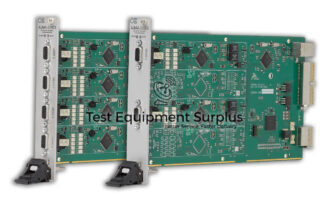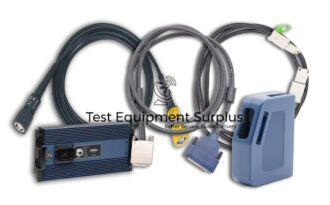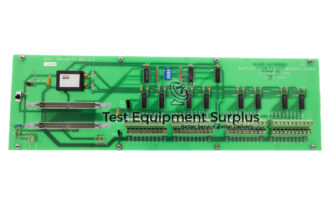Description
The National Instruments VXIpc-860 Embedded Computer is a robust system designed to be used as a System Controller within a VXIbus chassis, specifically when installed in Slot #0. It is powered by a Pentium III processor and is essential for managing complex data transfer operations, thanks to its arbiter that efficiently handles bus requests across four levels of the VXIbus.
Equipped with a 16 MHz oscillator, the VXIpc-860 maintains the system clock, ensuring precise timing and synchronization within the VXIbus environment. Additionally, it takes charge of the 10 MHz CLK 10 signal, providing it on a differential ECL output for reliable signal integrity.
With regards to connectivity, this embedded computer includes two RS-232 serial bus connectors, a VGA controller for display purposes, an Ethernet port for network connectivity, and both a trigger input and output connector, facilitating a wide range of external communications and control options.
The device also caters to user interface needs, supporting both a PS/2 keyboard and mouse. All input and output connectors are conveniently accessible through the front panel, designed to fit within a C-size form factor, making it user-friendly and easily maintainable.
The VXIpc-860’s architecture comprises a PCI-based CPU card, a 32-bit PCI Local Bus, an ISA Bus for legacy support, and the integral VXI bus, allowing it to accommodate various peripheral devices and expansion options. Its ISA Bus capability ensures that users can integrate multiple PC peripherals, enhancing the system’s versatility.
Lastly, an advanced automatic Slot-0 detection feature simplifies setup by identifying the controller’s slot position within the VXIbus chassis, with the flexibility to bypass this function for Non-Slot 0 operations, thus offering adaptability to different system configurations.
| Specification | Detail |
|---|---|
| Product | National Instruments VXIpc-860 Embedded Computer |
| Processor | Pentium III |
| Role in VXIbus | System Controller when deployed in Slot #0 |
| Data Transfer Bus Arbiter | Manages bus requests on four request levels of VXIbus |
| Oscillator Frequency | 16 MHz |
| System Clock | Drives 16 MHz system clock |
| CLK 10 Signal | Controls and drives the 10 MHz CLK 10 signal on a differential ECL output |
| Connectivity | 2 RS-232 serial bus connectors, 1 VGA controller, 1 Ethernet connector, 1 trigger output connector, 1 trigger input connector |
| Peripheral Support | Supports a PS/2 keyboard and mouse |
| Access to I/O Connectors | Front panel access in a C-size form factor |
| Buses | PCI-based CPU card, 32-bit PCI Local Bus, ISA Bus, and VXI bus |
| ISA Bus | Enables the device to hold multiple PC peripherals |
| Slot-0 Detection | Automatic Slot-0 detection circuitry, with the ability to bypass for Non-Slot 0 operation |
Question 1: What are the specific functions and capabilities of the VXIbus arbiter within the National Instruments VXIpc-860 Embedded Computer, and how does it contribute to managing complex data transfers?
Answer 1: The VXIbus arbiter within the National Instruments VXIpc-860 Embedded Computer manages complex data transfers by efficiently handling bus requests across four levels of the VXIbus, which ensures smooth and prioritized communication between devices, contributing significantly to the system’s ability to process and transfer large amounts of data within a VXIbus chassis.
Question 2: What are the specifications and features of the National Instruments VXIpc-860 Embedded Computer in terms of its processor, bus system, connectivity options, user interface, and expansion capabilities?
Answer 2: The National Instruments VXIpc-860 Embedded Computer serves as a System Controller in a VXIbus chassis, offering functionalities such as complex data transfer management with its arbiter, precise timing and synchronization with a 16 MHz oscillator and 10 MHz CLK 10 signal provision, interface capabilities with two RS-232 serial bus connectors, VGA, Ethernet, trigger input and output, and support for PS/2 keyboard and mouse, all designed to enhance user interaction and system efficiency within the VXIbus environment
Question 3: What type of processor is the National Instruments VXIpc-860 Embedded Computer equipped with, and what are its key functions and connectivity options within a VXIbus chassis?
Answer 3: The National Instruments VXIpc-860 Embedded Computer serves as the System Controller in a VXIbus chassis, typically installed in Slot #0, where it manages complex data transfer operations efficiently through its Pentium III processor and an arbiter that orchestrates bus requests across four levels of the VXIbus, supported by a 16 MHz oscillator that maintains precise system timing and synchronization.
Question 4: What functionalities does the National Instruments VXIpc-860 Embedded Computer offer in terms of system control, timing, synchronization, and interface within a VXIbus environment?
Answer 4: The National Instruments VXIpc-860 Embedded Computer features a Pentium III processor, a bus system with an arbiter for managing VXIbus operations across four levels, a 16 MHz oscillator for system clock timing, and connectivity options including two RS-232 serial ports, a VGA controller, an Ethernet port, and trigger input/output connectors. Its user interface supports a PS/2 keyboard and mouse, and the expansion capabilities include a PCI-based CPU card, a 32-bit PCI Local Bus,
Question 5: What role does the National Instruments VXIpc-860 Embedded Computer play within a VXIbus chassis, and what specific technologies contribute to its efficient management of complex data transfer operations?
Answer 5: The National Instruments VXIpc-860 Embedded Computer is equipped with a Pentium III processor and serves as a System Controller in a VXIbus chassis, managing complex data transfers with an efficient arbiter, maintaining precise system timing with a 16 MHz oscillator, and offering connectivity options such as two RS-232 serial bus connectors, a VGA controller, an Ethernet port, and trigger input/output connectors, while supporting PS/2 keyboard and mouse, and providing PCI and ISA bus compatibility for peripheral and expansion





